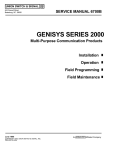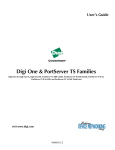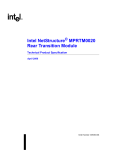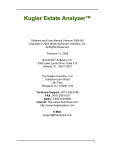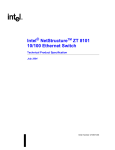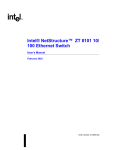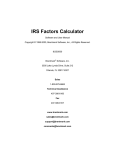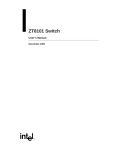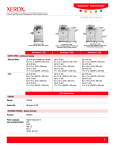Download Insignia NS-SBAR Home Theater System User Manual
Transcript
Intel NetStructure® ZT 4807 Packet Switched Rear Panel Transition Board Technical Product Specification Document Number: 302768 Revision History Revision Date Revision History 11/16/01 Initial Release 1/17/02 Added note saying Ethernet is not functional on standard product. Updated Functional Block Diagram. Clarified power connector documentation. Added floppy/IDE power cable descriptions. CTs 6-16 have been removed from the product and documentation. 3/20/02 Documented IDE/floppy cable A86460-001. Removed references to obsolete cables 18031 and 19021. 1/08/03 Corrected Customer Support Information. 5/28/03 Added Warranty information. 7/04 Faceplate change to remove Ethernet ports. 3/24/06 Removed Ethernet connectors J3, J18 and J20. INFORMATION IN THIS DOCUMENT IS PROVIDED IN CONNECTION WITH INTEL® PRODUCTS. EXCEPT AS PROVIDED IN INTEL’S TERMS AND CONDITIONS OF SALE FOR SUCH PRODUCTS, INTEL ASSUMES NO LIABILITY WHATSOEVER, AND INTEL DISCLAIMS ANY EXPRESS OR IMPLIED WARRANTY RELATING TO SALE AND/OR USE OF INTEL PRODUCTS, INCLUDING LIABILITY OR WARRANTIES RELATING TO FITNESS FOR A PARTICULAR PURPOSE, MERCHANTABILITY, OR INFRINGEMENT OF ANY PATENT, COPYRIGHT, OR OTHER INTELLECTUAL PROPERTY RIGHT. Intel Corporation may have patents or pending patent applications, trademarks, copyrights, or other intellectual property rights that relate to the presented subject matter. The furnishing of documents and other materials and information does not provide any license, express or implied, by estoppel or otherwise, to any such patents, trademarks, copyrights, or other intellectual property rights. Intel products are not intended for use in medical, life saving, life sustaining, critical control or safety systems, or in nuclear facility applications. Intel may make changes to specifications and product descriptions at any time, without notice. Designers must not rely on the absence or characteristics of any features or instructions marked “reserved” or “undefined.” Intel reserves these for future definition and shall have no responsibility whatsoever for conflicts or incompatibilities arising from future changes to them. The Intel NetStructure® ZT 4807 may contain design defects or errors known as errata which may cause the product to deviate from published specifications. Current characterized errata are available on request. This manual as well as the software described in it is furnished under license and may only be used or copied in accordance with the terms of the license. The information in this manual is furnished for informational use only, is subject to change without notice, and should not be construed as a commitment by Intel Corporation. Intel Corporation assumes no responsibility or liability for any errors or inaccuracies that may appear in this document or any software that may be provided in association with this document. Except as permitted by such license, no part of this document may be reproduced, stored in a retrieval system, or transmitted in any form or by any means without the express written consent of Intel Corporation. Contact your local Intel sales office or your distributor to obtain the latest specifications and before placing your product order. Copies of documents which have an ordering number and are referenced in this document, or other Intel literature may be obtained by calling 1-800-548-4725 or by visiting Intel's website at http://www.intel.com. Intel, Intel Centrino, Intel logo, Intel NetStructure, and Pentium III are trademarks or registered trademarks of Intel Corporation or its subsidiaries in the United States and other countries. *Other names and brands may be claimed as the property of others. Copyright © 2001-2006, Intel Corporation. All rights reserved. Contents 1. INTRODUCTION ....................................................................................................................................................8 UNPACKING ...............................................................................................................................................................8 PRODUCT DEFINITION ...............................................................................................................................................8 FEATURES OF THE ZT 4807 .....................................................................................................................................9 FUNCTIONAL BLOCKS .............................................................................................................................................10 Rear-Panel I/O..................................................................................................................................................10 PS/2 Keyboard/Mouse Port ............................................................................................................................10 Video Interface .................................................................................................................................................11 Universal Serial Bus ........................................................................................................................................11 Serial Port Connectors (COM1 and COM2).................................................................................................11 EIDE Interface ..................................................................................................................................................11 Speaker Connector..........................................................................................................................................12 Floppy Drive Interface and Power Connector..............................................................................................12 2. COMPACTFLASH OPTION...............................................................................................................................13 COMPACTFLASH INPUT CHARACTERISTICS ...........................................................................................................13 CompactFlash Card Installation and Removal ............................................................................................14 3. CONFIGURATION...............................................................................................................................................15 ZT 4807 SWITCH OPTIONS AND LOCATIONS .........................................................................................................15 Switch Descriptions .........................................................................................................................................15 CUTTABLE TRACES .................................................................................................................................................17 Cuttable Trace Descriptions ...........................................................................................................................17 A. SPECIFICATIONS ..............................................................................................................................................20 ELECTRICAL SPECIFICATIONS ................................................................................................................................20 ENVIRONMENTAL SPECIFICATIONS .........................................................................................................................20 MECHANICAL SPECIFICATIONS ...............................................................................................................................20 Board Dimensions and Weight ......................................................................................................................21 Connectors........................................................................................................................................................22 Cables................................................................................................................................................................30 B. AGENCY APPROVALS .....................................................................................................................................31 CE CERTIFICATION .................................................................................................................................................31 SAFETY....................................................................................................................................................................31 EMISSIONS TEST REGULATIONS.............................................................................................................................31 EN 50081-1 Emissions....................................................................................................................................31 EN 55024 Immunity .........................................................................................................................................31 REGULATORY INFORMATION ...................................................................................................................................32 FCC (USA) ........................................................................................................................................................32 Industry Canada (Canada) .............................................................................................................................32 PRODUCT SAFETY INFORMATION ...........................................................................................................................32 Safety Precautions...........................................................................................................................................32 AC and/or DC Power Safety Warning (AC and/or DC Powered Units) ...................................................34 Rack Mount Enclosure Safety........................................................................................................................34 D. INTEL NETSTRUCTURE® COMPUTE BOARDS & PLATFORM PRODUCTS .......................................35 LIMITED WARRANTY ................................................................................................................................................35 3 Contents C. CUSTOMER SUPPORT.....................................................................................................................................37 T TECHNICAL SUPPORT AND RETURN FOR SERVICE ASSISTANCE...........................................................................37 SALES ASSISTANCE ................................................................................................................................................37 4 Tables Revision History ............................................................................................................................2 CompactFlash Input Characteristics ...........................................................................................13 Cuttable Trace Definitions...........................................................................................................17 Connector Assignments ..............................................................................................................22 J5 Rear-Panel User I/O Connector Pinout ..................................................................................24 J6 Speaker Connector Pinout .....................................................................................................25 J8/J9 Power Connector Pinout....................................................................................................25 J10 Floppy Drive Cable Connector Pinout ..................................................................................26 J11 EIDE Connector Pinout ........................................................................................................27 J13/J14 Universal Serial Bus Connector Pinout .........................................................................28 J15 Keyboard/Mouse Connector Pinout .....................................................................................28 J16/J17 COM1/COM2 Connectors Pinout ..................................................................................29 J19 VGA Interface Connector Pinout ..........................................................................................29 5 Figures Functional Block Diagram ...........................................................................................................10 Switch and Cuttable Trace Locations..........................................................................................18 Board Dimensions.......................................................................................................................21 Connector Locations ...................................................................................................................23 Backplane Connectors—Pin Locations.......................................................................................23 6 Document Organization This Technical Product Specification describes the operation and use of the Intel NetStructure® ZT 4807 Packet Switched Rear Panel Transition Board. The following summarizes the focus of each major section of this Specification. Chapter 1, “Introduction,” introduces the key features of the ZT 4807. It includes a product definition, a list of product features, a functional block diagram, and a brief description of each block. Chapter 2, “CompactFlash Option” details how to use a CompactFlash expansion card to provide external solid-state secondary IDE channel capacity. Chapter 3, “Configuration,” describes factory default settings and board options configurable through the ZT 4807’s switches and cuttable traces. Appendix A, “Specifications,” contains the electrical, environmental, and mechanical specifications for the ZT 4807. It provides an illustration of connector locations, connector descriptions, and tables of the connector pin assignments. It also presents information on cabling recommended by Intel. Appendix B, “Agency Approvals,” presents agency approvals and certifications pending for the ZT 4807. Appendix C, “Customer Support,” provides technical and sales assistance information. 7 1. Introduction This chapter provides a brief introduction to the Intel NetStructure® ZT 4807 Packet Switched Rear Panel Transition Board (RPIO). It includes a product definition, a list of product features, a “ZT 4807 Connector Plate” figure, a functional block diagram, and a description of each block. See Chapter 3, “Configuration,” for factory default settings and board options configurable through the ZT 4807’s switches and cuttable traces. See Appendix A, “Specifications,” for complete power and temperature requirements, as well as connector locations, descriptions, pinout tables, and cable recommendations. Unpacking Please check the shipping carton for damage. If the shipping carton and contents are damaged, notify the carrier and Intel for an insurance settlement. Retain the shipping carton and packing material for inspection by the carrier. Do not return any product to Intel without a Return Material Authorization (RMA) number. The "Technical Support/Return for Service" topic in Appendix A provides contact information for obtaining an RMA number from Intel. Warning: Like all equipment utilizing MOS devices, the ZT 4807 must be protected from static discharge. Never remove any of the socketed parts except at a static-free workstation. Use the anti-static bag shipped with your order to handle the boards. Product Definition The ZT 4807 is a single slot, 6U board providing rear-panel access to the I/O functions of an Intel NetStructure® processor board with RPIO pin compatibility (see the pin definitions for connector J5 in Appendix A). An example of a compatible board is the Intel NetStructure® ZT 5504. The ZT 4807 is designed to function only in the RPIO slot of a 6U CompactPCI* system such as the Intel NetStructure® ZT 5090 4U General Purpose Packet Switched Platform. 8 1. Introduction Features of the ZT 4807 • • Rear-panel interface connectors for host processor board: − USB 0 and USB1 ports − VGA − PS/2 Keyboard/Mouse − COM 1 − COM 2 Internal interfaces not on the connector plate: − CompactFlash interface − IDE interface (Host processor board secondary channel) − 4-pin power connector for external media − Floppy interface − PC speaker connector • Reset Switch • NMI Switch 9 1. Introduction Functional Blocks Below is a functional block diagram of the ZT 4807. The topics following the diagram provide overviews of the ZT 4807's functional blocks. ZT 4807 Functional Block Diagram J5 Rear-Panel I/O POWER IN (J8) EIDE POWER OUT (J9) COM2 (J17) FLOPPY (J10) SPEAKER (J6) COM1 (J16) KEYBOARD & MOUSE (J15) (CompactFlash and Secondary Channels) (J11-J12) VIDEO (J19) USB 0 USB 1 (J13) (J14) Rear-Panel I/O The ZT 4807 transitions signals from a pin-compatible processor board (such as the ZT 5504 from Intel) through backplane connectors J5. PS/2 Keyboard/Mouse Port The ZT 4807 provides rear-panel access to the host processor board keyboard/mouse interface. The host processor board PS/2 style mouse/keyboard controller is connected via RPIO connector J5 to 6-pin DINN connector J15, labeled KY/MS on the ZT 4807 Connector Plate. Using J15 for both the PS/2 keyboard and PS/2 mouse connection requires use of a PC keyboard/mouse ‘Y’ splitter cable. See the “Cables” topic in Appendix A for cabling recommendations. Note: The keyboard and mouse do not function properly if devices are connected to both the Host processor board and the ZT 4807. 10 1. Introduction Video Interface The ZT 4807 provides rear-panel access to the host processor board VGA accelerator. The host processor board VGA accelerator is connected via RPIO connector J5 to J19, a 15-pin VGA connector on the ZT 4807 Connector Plate. Note: Video does not function properly if devices are connected to both the Host processor board and the ZT 4807. Universal Serial Bus The ZT 4807 provides rear-panel access to the host processor board Universal Serial Bus (USB) signals. The host processor board USB is connected via RPIO connector J5 to USB connectors J13 and J14 on the ZT 4807 Connector Plate. Serial Port Connectors (COM1 and COM2) The ZT 4807 provides rear-panel access to the host processor board serial ports. The host processor board COM1 and COM2 ports are connected via RPIO connector J5 to 9-pin Dshell connectors J16 and J17, respectively, on the ZT 4807 Connector Plate. Note: The COM Ports do not function properly if devices are connected to the same COM port channel on both the host processor board and the ZT 4807. EIDE Interface The host processor board secondary channel is connected via RPIO connector J5 to internal 40-pin 0.1” vertical header J11 and to internal CompactFlash connector J12 on the ZT 4807. Only two IDE devices can be connected on any IDE channel. If the ZT 4807 has a CompactFlash device installed, only a single IDE device can be connected to secondary IDE channel connector J11. Refer to Chapter 2, “CompactFlash Option,” for installation and configuration of the ZT 4807 for operation with a CompactFlash device. Caution: For proper operation, Intel recommends an ATA-5 compliant 80-conductor IDE cable for external IDE connection. If the external IDE device is configured in a master/slave combination with an on-board IDE device (CompactFlash or processor board-mounted hard disk), a custom 80-conductor IDE cable must be used. Use of industry standard 80-conductor IDE cables in this configuration can cause BIOS drive detection and configuration errors. See the “Cables” topic in Appendix A for cabling recommendations. An IDE drive that requires +12V/GND/+5V to operate can be connected to power output connector J9. Input power connector J8 must then be connected to a power source supplying +12V/GND/+5V. Refer to the “Cables” topic in Appendix A for more information. 11 1. Introduction Speaker Connector The host processor board speaker interface is connected via RPIO connector J5 to internal speaker connector J6, allowing connection of a PC speaker. Floppy Drive Interface and Power Connector The host processor board floppy drive controller is connected via RPIO connector J5 to internal 34-pin floppy drive cable connector J10. The ZT 4807 also provides a 4-pin power connector (J9) that provides +5V, GND, and +12V when input power connector J8 is connected to an appropriate power source. Caution: If power is supplied to J8 from the host processor board and the device connected to J9 draws more power than the host processor board can provide, a power fault or other problems may occur. 12 2. CompactFlash Option CompactFlash connector J12 on the ZT 4807 provides external, solid state, secondary IDE channel capability to a processor board such as the Intel NetStructure® ZT 5504 System CPU Board with Intel Pentium® III processor. This connector is designed to accommodate CompactFlash expansion cards operating in True IDE Mode, which appear to the system as a hard drive and are automatically supported by most operating systems. CompactFlash Input Characteristics By default, the ZT 4807’s CompactFlash socket (J12) is set to 5.0V operation (CT5 is in position B). This setting requires the CompactFlash card to have “Type 2” or “Type 3” input characteristics, as shown in the “CompactFlash Input Characteristics” table below. SanDisk* currently manufactures cards meeting these specifications. CompactFlash Input Characteristics Min Type Parameter Symbol Typ. Max Min Typ. Max VCC = 3.3 (CT5A)1 VCC = 5.0 (CT5B)2 Input Vih 2.4 — — 4.03 — — Voltage CMOS Vil — — 0.6 — — 0.8 Input Vih 1.5 — — 2.0 — — Voltage CMOS Vil — — 0.6 — — 0.8 Input Vth — 1.8 — — 2.8 — Voltage CMOS Vtl — 1.0 — — 2.0 — 1 Units Volts 2 Volts 3 Volts Notes: This table is based on one provided in the CompactFlash Specification Revision 1.3. The shaded area represents operation not supported on the ZT 4807. 1. If the CompactFlash socket (J12) is set for VCC = 3.3V operation (CT5 is in the A position), do not connect a disk drive on the EIDE connector J11. Doing so will damage the CompactFlash device! 2. Factory default configuration. 3. CompactFlash cards with “Type 1” input characteristics (operating from VCC = 5.0) should not be used because the ZT 4807 does not meet the 4.0V minimum input voltage requirement (ZT 4807 EIDE channels VOH = 2.8V). 13 2. CompactFlash Option 5.0V operation has the advantage of allowing master/slave operation, with an additional drive connected to the secondary IDE connector J11 on the ZT 4807. See the “SW4-1 (Secondary IDE Master/Slave Selection)” topic in Chapter 3, “Configuration,” for more information about configuring the CompactFlash card as a master or slave IDE device on the secondary channel. Caution: If a CompactFlash device is present, and an IDE device is connected to J11, a custom 80-conductor IDE cable must be used. Use of industry standard 80-conductor IDE cables in this configuration can cause BIOS drive detection and configuration errors. See the “Cables” topic in Appendix A for cabling recommendations. CompactFlash Card Installation and Removal Perform the steps below to install or remove a CompactFlash card. Caution: Perform the installation and removal at a static-free workstation to avoid damage to the ZT 4807. Installation 1. Make sure the system is powered off. 2. Put on an anti-static grounding strap. 3. Most CompactFlash cards have an arrow on the top label indicating correct orientation. Align the arrow on the CompactFlash card with the arrow on the connector and slide the card into place until the connection is snug. The dimensions of the grooves in the sides of the CompactFlash card prevent incorrect installation. Removal 1. Make sure the system is powered off. 2. Put on an anti-static grounding strap. 3. Grasp the card by the sides and pull it out of the connector. Do not apply pressure to the top of the CompactFlash cards: this can damage some CompactFlash devices such as the IBM Microdrive*. 14 3. Configuration The ZT 4807 includes several options that tailor the operation of the board to requirements of specific applications. Some options are configured with a switch or by cuttable traces. Configure a switch option by closing or opening a DIP switch. Configure a cuttable trace option by installing or removing a surface mount 0 Ω resistor. ZT 4807 Switch Options and Locations The ZT 4807 includes one bank of switches (SW4) located on the component side of the board. See the “Switch and Cuttable Trace Locations” figure for the location of the SW4. SW1 is incorporated into the lower board ejector mechanism. SW2 and SW3 are pushbutton switches located on the connector plate. See the “ZT 4807 Connector Plate” figure in Chapter 1 for the location of the SW2 and SW3. Switch Descriptions The following topics list the switches in numerical order and provide a detailed description of each switch. Note that where switches are referenced in this Chapter, “SWx” corresponds to the switch number and “-N” corresponds to the switch segment (for example, SW2-1 means “switch number 2, segment 1”). SW1 (Hot Swap Ejector) The lower ejector incorporates an ejector switch, connected to the processor board’s Baseboard Management Controller. This switch is used to notify the processor board of the necessity to shut down so the ZT 4807 can be removed. SW2 (Reset) SW2 is a push-button on the ZT 4807's connector plate. See the “ZT 4807 Connector Plate” figure in Chapter 1 for the location of the SW2. When pressed, SW2 issues a reset to the host processor board. See the host processor board manual for a detailed description of the reset feature. SW3 (NMI) SW3 is a push-button on the ZT 4807's connector plate. See the “ZT 4807 Connector Plate” figure in Chapter 1 for the location of the SW3. When pressed, SW2 issues a non-maskable interrupt to the host processor board. See the host processor board manual for a detailed description of the reset feature. 15 3. Configuration SW4-1 (Secondary IDE Master/Slave Selection) SW4-1 configures the CompactFlash card (installed in J12) as a master or slave IDE device on the secondary channel. This switch also changes the polarity of the “Cable Select” signal available at connector J11, pin 28. If the CompactFlash card is the only device on the secondary IDE channel then it must be configured as the master (SW4-1 = on). If another IDE device is connected to the secondary IDE channel (cabled to connector J11) then the CompactFlash should be configured as a slave (SW4-1 = off) and the other device should be configured as the master. See the documentation supplied with your IDE device to see how to configure it as a master. If a CompactFlash card is not installed in J12, then SW4-1 should be off. SW4-1 affects the “Cable Select” (J11 pin 28) signal on the IDE cable. For normal “cable select” operation SW4-1 must be off. A maximum of two IDE devices may be connected to the secondary channel. If you have a CompactFlash card installed in J12 then you may have only one IDE device connected to J11 and you must use a special cable to connect the external IDE device to J11. This cable is available from Intel as part number ZT 90250. See the “Cables” topic in Appendix A for more information. If a CompactFlash card is not installed in J12 then two devices may be installed on the cable connected to J11. A standard 80-pin (UDMA-66 compatible) cable may be used in this case. The ZT 4807 is supplied without a CompactFlash card installed in J12. Therefore SW4-1 is off by default. See the “CompactFlash Input Characteristics” topic in Chapter 2 for more information. SW4-2, SW4-3, SW4-4 (Reserved) These switch segments are reserved for future use. Factory default is open. 16 3. Configuration Cuttable Traces The ZT 4807 includes several cuttable traces (0 Ω shorting resistors) that allow the user to configure certain options not configurable through the processor board's BIOS Setup Utility. In most cases, the default settings are appropriate for normal operation; however, some applications may require different settings. The "Switch and Cuttable Trace Locations" figure shows the placement of the ZT 4807's cuttable traces. There are two types of cuttable traces on the ZT 4807: single-option and double-option: • Single option cuttable traces are implemented using 0603 and 1206 surface mount pads. A 0 Ω shorting resistor is soldered between these pads to make the connection. • Double option cuttable traces are implemented using three 0603 surface mount pads. A 0 Ω shorting resistor is soldered between one set of pads, depending on the chosen option. Caution: Only qualified technicians familiar with surface mount soldering techniques should perform cuttable trace modifications. The product warranty is voided if the board is damaged by customer modifications. Cuttable Trace Descriptions The “Cuttable Trace Definitions” table provides a quick cross-reference for the ZT 4807 cuttable trace descriptions that follow. Cuttable Trace Definitions CT# Default Description CT1 Out Connect Top ESD Strip to Logic Ground CT2 Out Connect Bottom ESD Strip to Logic Ground CT3 Out Connect Reset Switch Case to Logic Ground CT4 Out Connect NMI Switch Case to Logic Ground CT5 B Connect Compact Flash Power to Switched 5V 17 3. Configuration Switch and Cuttable Trace Locations CT1 CT5 4 3 2 1 SW4 CT3 CT4 SW2 SW3 CT2 18 3. Configuration CT1-CT4 (Connect Chassis GND to Logic GND) The ZT 4807's switches and ejectors are on an isolated chassis ground. These components can be connected to the ZT 4807 logic ground by installing these four cuttable traces. All four cuttable traces should be installed or all four removed. The factory default is removed. Position Function All In Front panel connectors connected to logic ground All Out Default Front-panel connectors not connected to logic ground CT5 (CompactFlash Operating Voltage) The factory default configuration sets the ZT 4807’s CompactFlash socket (J12) to 5.0V operation (CT5 in position B). This setting requires the CompactFlash card to have “Type 2” or “Type 3” input characteristics. See the “CompactFlash Input Characteristics” table in Chapter 3 for more information. Caution: If the CompactFlash socket is set for VCC = 3.3V operation (CT5 is in the A position), do not connect a disk drive on EIDE connector J11. Doing so will damage the CompactFlash device! Position Function A Connects the Compact Flash Circuitry to Switched 3.3VDC. B Default Connects the Compact Flash Circuitry to Switched 5VDC. 19 A. Specifications This Appendix describes the electrical, environmental, and mechanical specifications of the ZT 4807. It includes illustrations of the board dimensions and connector locations, as well as connector pinout tables. Electrical Specifications Power Requirements Minimum Typical Maximum Supply Voltage, VCC 4.75V 5.00V 5.25V Supply Current, VCC = 5.0V 0mA -- 195mA Environmental Specifications Operating Temperature: 0° to +70° Celsius Storage Temperature: -40° to +85° Celsius Relative Humidity: < 95% at 40° Celsius, non-condensing Mechanical Specifications The topics listed below provide the following mechanical specifications: • Board Dimensions and Weight • Connectors (including connector locations, descriptions, and pinouts) 20 A. Specifications Board Dimensions and Weight Mechanical dimensions for the ZT 4807 are shown in the "Board Dimensions" illustration and outlined below. Board Length: 80mm (3.150 in) Board Width: 233.35mm (9.187 in) Board Thickness: 1.6mm (0.063 in) Board Weight: 202 g (7.13 oz) 80.00 mm Board Dimensions 233.35 mm 21 A. Specifications Connectors As shown in the “Connector Locations” drawing, the ZT 4807 includes several connectors to interface with application-specific devices. A brief description of each connector is given in the “Connector Assignments” table. A detailed description and pinout for each connector is given in the following topics. Connector Assignments Connector Function J5 Rear-Panel User I/O Connector (110-pin, 2mm x 2mm, female) J6 Speaker Connector (2-pin, male) J7 Ejector switch connector J8 Floppy Drive/IDE Input Power Connector (4-pin, female) J9 Floppy Drive/IDE Output Power Connector (4-pin, female) J10 Floppy Drive Cable Connector (34-pin, male) J11 Secondary EIDE Connector (40-pin, male) J12 CompactFlash Connector (50-pin, CF Card Slot Header) J13, J14 Universal Serial Bus Connectors (4-pin, USB, Port 1/Port 1) J15 PS/2 Keyboard/Mouse Connector (6-pin, DIN) J16 COM1 Serial Port (9-pin, D-Shell) J17 COM2 Serial Port (9-pin, D-Shell) J19 VGA Interface Connector (15-pin D-shell, female) 22 A. Specifications Connector Locations J5 Keyboard/Mouse, USB0, USB1, SVGA, Reset, NMI, Secondary IDE, CompactFlash, Floppy, COM1, COM2,Floppy Power, Speaker J12 CompactFlash J13 USB 0 J14 USB 1 J19 Video J1 1 Secondary IDE Channel J6 Speaker Connector J15 Keyboard/Mouse Port J16 COM1 J8 12 VDC In J9 12 VDC Out J17 COM2 J10 Floppy Connector J7 Ejector switch Backplane Connectors—Pin Locations E D C B A 22 J5 1 23 A. Specifications J5 (Rear-Panel User I/O Connector) J5 is a 110-pin, 2mm x 2mm, right angle, female connector (AMP 646489-1) capable of transitioning the following signals for rear-panel I/O: • Keyboard/Mouse • COM1 • VGA • Reset • Floppy • USB0, USB1 • Compact Flash • COM2 • NMI • IDE • Floppy Power • Speaker See the “J5 Rear-Panel User I/O Connector Pinout” table for pin definitions and the “Backplane Connectors—Pin Locations” figure showing pin placement. J5 Rear-Panel User I/O Connector Pinout A B C D E 22 USB0+ USB0- SW-5V USB1+ USB1- 21 SW-3.3V GND GND GND GND 20 RED GND H-SYNC GND SMBD 19 GND SW-5V GND SW-5V SMBC 18 GREEN GND V-SYNC GND SMBA- 17 GND RESV RP_PRES- RESV IPMB PWR 16 BLUE GND DDCCLK KBDAT KBCLK 15 GND SW-5V DDCDAT MSDAT MSCLK 14 S1RTS S1CTS S1RIN S1DTR ENETA-LINK 13 S1DCD S1TXD S1RXD S1DSR ENETA-ACT 12 S2RTS S2CTS S2RIN S2DTR ENETB-LINK 11 S2DCD S2TXD S2RXD S2DSR ENETB-ACT 10 TRK0- WP- RDATA- HDSEL- DSKCHG- 9 MTR1- DIR- STEP- WDATA- WGATE- 8 DENSL INDEX- MTR0- DR1- DR0- 7 CS1S- CS3S- DA1 RPELED RPEJECT- 6 PWRGD SPKR NMI- DA0 DA2 5 DDRQ IORDY DI0W- DDACK DIOR- 4 DD14 DD0 IDE_ACT DD15 DRV_IRQ 3 DD3 DD12 DD2 DD13 DD1 2 DD9 DD5 DD10 DD4 DD11 1 PBRST- DRST- DD7 DD8 DD6 Pin A B C D E F Ground Shield Pin F 24 A. Specifications J6 (Speaker Connector) J6 is a 2-pin connector (Molex 39-27-0021) for connection to an optional PC speaker. The mating connector is a Molex 39-01-0023 or equivalent. The mating connector also requires two Molex 39-01-0031 terminals or equivalent. If you experience difficulty locating parts information from the Molex website, contact your Molex sales representative at 1-80078MOLEX. See the “J6 Speaker Connector Pinout” for pin definitions and the “Connector Locations” figure to identify J6 on the ZT 4807. J6 Speaker Connector Pinout Pin Function 1 SPK1 2 SPK2 J8, J9 (Floppy Drive/IDE Power Connectors) J8 and J9 are internal (not available on the faceplate), four position, female power connectors (AMP 174552-1) with +5V, GND, and +12V pins. Power can be supplied to input power connector J8 from an appropriate external power source supplying +5V, GND, and +12V. Output power connector J9 can then supply power to an external device such as a floppy drive or IDE device. See the “Cables” topic for more information. Caution: If power is supplied to J8 from the host processor board and the device connected to J8 draws more power than the host processor board can provide, a power fault or other problems may occur. See the”J8/J9 Power Connector Pinout” table for pin definitions and the “Connector Locations” figure to identify J8 and J9 on the ZT 4807. J8/J9 Power Connector Pinout Pin Function 1 +12V 2 Ground 3 Ground 4 +5V 25 A. Specifications J10 (Floppy Drive Cable Connector) J10 is an internal (not available on the faceplate) 34-pin connector (AMP 104340-7) providing a ribbon cable interface for the processor board's floppy drive signals. See the “J10 Floppy Drive Cable Connector Pinout” table for pin definitions and the “Connector Locations” figure to identify J10 on the ZT 4807. J10 Floppy Drive Cable Connector Pinout Pin Function Pin Function 1 Ground 2 DENSL 3 Ground 4 N/C 5 Ground 6 N/C 7 Ground 8 INDEX- 9 Ground 10 MTR0- 11 Ground 12 DR1- 13 Ground 14 DR0- 15 Ground 16 MTR1- 17 Ground 18 DIR- 19 Ground 20 STEP- 21 Ground 22 WDATA- 23 Ground 24 WGATE- 25 Ground 26 TRK0- 27 Ground 28 WP- 29 Ground 30 RDATA- 31 Ground 32 HDSEL- 33 Ground 34 DSKCHG- 26 A. Specifications J11 (EIDE Connector) J11 is an internal (not on the connector plate), 40-pin, male, unshrouded, 0.25" square posts on 0.1" 2 x 20 grid connector (T&B 609-4027). J11 provides access to the processor board's secondary EIDE channel. The secondary channel is connected from RPIO connector J5 to the internal IDE connector J11 and the CompactFlash Connector J12. See the “J11 EIDE Connector Pinout” table for pin definitions and the “Connector Locations” figure to identify J11 on the ZT 4807. J11 EIDE Connector Pinout Pin Function Pin Function 1 Reset IDE# 2 Ground 3 Data 7 4 Data 8 5 Data 6 6 Data 9 7 Data 5 8 Data 10 9 Data 4 10 Data 11 11 Data 3 12 Data 12 13 Data 2 14 Data 13 15 Data 1 16 Data 14 17 Data 0 18 Data 15 19 Ground 20 N/C 21 DDRQ 22 Ground 23 DIOW# 24 Ground 25 DIOR# 26 Ground 27 DRDY 28 CSEL (Cable Select pull-down) 29 DDAK# 30 Ground 31 IRQ 14 32 Reserved 33 IDE_A1 34 Reserved 35 IDE_A0 36 IDE_A2 37 IDE_CS1# 38 IDE_CS3# 39 IDE_ACT# 40 Ground 27 A. Specifications J12 (CompactFlash Connector) J12 is a 50-pin, surface mount, right angle, CF card slot header (AMP 788667-1) designed to accommodate a CompactFlash card. Refer to the CompactFlash Specification, Revision 1.X, for pinout and device information. For a copy of the most current specification and more information about CompactFlash, visit the CompactFlash Association’s website at: http://www.compactflash.org/ Refer to the “Connector Locations” figure to identify J12 on the ZT 4807. J13/J14 (Universal Serial Bus Connectors) J13 and J14 are the rear-panel interface (AMP 440260-1) for the processor board's USB Ports 0 and 1, respectively. J13 and J14 can be used simultaneously with the USB connectors on the processor board's connector plate. See the “J13/J14 Universal Serial Bus Connector Pinout” table for pin definitions and the “Connector Locations” figure to identify J13 and J14 on the ZT 4807. J13/J14 Universal Serial Bus Connector Pinout Pin Function 1 +5V (Fused) 2 DATA- 3 DATA+ 4 Ground J15 (Keyboard/Mouse Connector) J15 is a 6-pin DINN connector (AMP 749180-1) for standard PS/2 style keyboard and Mouse devices. See the “J15 Keyboard/mouse Connector Pinout” table for pin definitions and the “Connector Locations” figure to identify J15 on the ZT 4807. J15 Keyboard/Mouse Connector Pinout Pin Function 1 Keyboard Data 2 Mouse Data 3 Ground 4 Switched +5V 5 Keyboard Clock 6 Mouse Clock 28 A. Specifications J16 and J17 (COM1/COM2 Connectors) J16 (COM1) and J17 (COM2) are 9-pin D-shell connectors (AMP 179952-3) providing an interface to the processor board’s COM channels. See the “J16/J17 COM1/COM2 Connectors Pinout” table for pin definitions and the “Connector Locations” figure to identify J16 and J17 on the ZT 4807. J16/J17 COM1/COM2 Connectors Pinout Pin Function Pin Function 1 Data Carrier Detect 6 DCE (Data Set) Ready 2 Received Data 7 Request to Send 3 Transmitted Data 8 Clear to Send 4 DTE (Data Terminal) Ready 9 Ring Indicator 5 Signal Ground J19 (VGA Interface Connector) J19 is an HD15, 15-pin, female, D-shell connector (AMP 177514-9) providing a rear-panel interface for the processor board’s video adapter. See the “J19 VGA Interface Connector Pinout” table for pin definitions and the “Connector Locations” figure to identify J19 on the ZT 4807. J19 VGA Interface Connector Pinout Pin Function Pin Function 1 RED 9 VCC 2 GRN 10 SGND 3 BLUE 11 N/C 4 N/C 12 SDA 5 DGND 13 HYSNC 6 RGND 14 VSYNC 7 GGND 15 SCL 8 BGND 29 A. Specifications Cables Intel recommends the following cables for interfacing to the ZT 4807. IDE For proper operation, Intel recommends 80-conductor IDE cables for external IDE connection. If the external IDE device is configured in a master/slave combination with an on-board IDE device (CompactFlash or processor board mounted hard disk) a custom 80conductor IDE cable must be used. Industry standard 80-conductor IDE cables do not connect PDIAG to the host connector. This causes BIOS drive detection and configuration errors when a master/slave pair exists across the interface. An 80-conductor IDE cable for use with the ZT 4807 is available as an accessory from Intel as part number ZT 90250. Floppy/IDE Power An IDE/floppy drive power cable (Intel part number A86460-001) is shipped with the ZT 4807. This is a 20" Y cable with a 4-pin female D-shell power connector wired to a 4-pin female mini-plug power connector and a second 4-pin female D-shell power connector. Use this cable to connect from ZT 4807 output power connector J9 to a floppy drive power input connector and/or an IDE device power input connector. PS/2 Keyboard/Mouse Using the ZT 4807 Keyboard/Mouse connector (J15) for both PS/2 keyboard and PS/2 mouse connection requires use of a PC keyboard/mouse Y splitter cable, such as the IBM ThinkPad Laptop Y Cable. This cable (P/N BC00210) may be obtained from Black Box Corporation. Contact Black Box at (724) 746-5500, or visit their website at http://www.blackbox.com. This cable can also be ordered as an accessory from Intel as ZT 90249. 30 B. Agency Approvals CE Certification The ZT 4807 meets intent of Directive 89/336/EEC for Electromagnetic Compatibility and Low-Voltage Directive 73/23/EEC for Product Safety. The ZT 4807 has been designed for NEBS/ETSI compliance. Safety UL/cUL 60950 Safety for Information Technology Equipment (UL File # E179737) EN/IEC 60950 Safety for Information Technology Equipment CB Report Scheme CB certificate and Report Emissions Test Regulations FCC Part 15, Subpart B EN 55022 CISPR 22 Bellcore GR-1089 EN 50081-1 Emissions GR-1089-CORE Sections 2 and 3 EN 55022 Class A Radiated EN 55022 Power Line Conducted Emissions EN 61000-3-2 Power Line Harmonic Emissions EN 61000-3-3 Power line Fluctuation and Flicker EN 55024 Immunity GR-1089-CORE Sections 2 and 3 EN 61000 4-2 Electro-Static Discharge (ESD) EN 61000 4-3 Radiated Susceptibility EN 61000 4-4 Electrical Fast Transient Burst EN 61000 4-5 Power Line Surge EN 61000 4-6 Frequency Magnetic Fields EN 61000 4-11 Voltage dips, Variations, and Short Interruptions 31 B. Agency Approvals Regulatory Information FCC (USA) This product has been tested and found to comply with the limits for a Class A digital device pursuant to Part 15 of the FCC rules. These limits are designed to provide reasonable protection against harmful interference when the equipment is operated in a commercial environment. This product generates, uses, and can radiate radio frequency energy and, if not installed and used in accordance with the instruction manual, may cause harmful interference to radio communications. Operation of this equipment in a residential area is likely to cause harmful interference in which case the user will be required to correct the interference at his own expense. Note: This device complies with Part 15 of the FCC Rules. Operation is subject to the following two conditions: 1. This device may not cause harmful interference. 2. This device must accept any interference received, including interference that may cause undesired operation. Caution: If you make any modification to the equipment not expressly approved by Intel, you could void your authority to operate the equipment. Industry Canada (Canada) Cet appareil numérique respecte les limites bruits radioélectriques applicables aux appareils numériques de Classe A prescrites dans la norme sur le matériel brouilleur: "Appareils Numériques", NMB-003 édictée par le Ministre Canadien des Communications. This digital apparatus does not exceed the Class A limits for radio noise emissions from digital apparatus set out in the interference-causing equipment standard entitled: "Digital Apparatus," ICES-003 of the Canadian Department of Communications. Product Safety Information Safety Precautions Review the following precautions to avoid injury and prevent damage to this product, or any products to which it is connected. To avoid potential hazards, use the product only as specified. 32 B. Agency Approvals Read all safety information provided in the component product user manuals and understand the precautions associated with safety symbols, written warnings, and cautions before accessing parts or locations within the unit. Save this document for future reference. Caution: To Avoid Electric Overload: To avoid electrical hazards (heat shock and/or fire hazard), do not make connections to terminals outside the range specified for that terminal. See the product user manual for correct connections. Caution: To Avoid the Risk of Electric Shock: When supplying power to the system, always make connections to a grounded main. Always use a power cable with a grounded plug (third grounding pin). Do not operate in wet, damp, or condensing conditions. Caution: System Airflow Requirements: Platform components such as processor boards, Ethernet switches, etc., are designed to operate with external airflow. Components can be destroyed if they are operated without external airflow. Chassis fans normally provide external airflow when components are installed in compatible chassis. Filler panels must be installed over unused chassis slots so that airflow requirements are met. Please refer to the product data sheet for airflow requirements if you are installing components in custom chassis. Caution: Microprocessor Heatsinks May Become Hot During Normal Operation: To avoid burns, do not allow anything to touch processor heatsinks. Caution: Do Not Operate Without Covers: To avoid electric shock or fire hazard, do not operate this product with any removed enclosure covers or panels. Caution: To Avoid the Risk of Electric Shock: Do not operate in wet, damp, or condensing conditions. Caution: Do Not Operate in an Explosive Atmosphere: To avoid injury, fire hazard, or explosion, do not operate this product in an explosive atmosphere. Caution: If Your System Has Multiple Power Supply Sources: Disconnect all external power connections before servicing. Warning: Power Supplies Must Be Replaced by Qualified Service Personnel Only. Caution: Lithium Batteries Are Not Field-Replaceable Units: There is a danger of explosion if a battery is incorrectly replaced or handled. Do not disassemble or recharge the battery. Do not dispose of the battery in fire. When the battery is replaced, the same type or an equivalent type recommended by the manufacturer must be used. Used batteries must be disposed of according to the manufacturer’s instructions. Return the unit to Intel for battery service. 33 B. Agency Approvals AC and/or DC Power Safety Warning (AC and/or DC Powered Units) The AC and/or DC power cord is your unit’s main AC and/or DC disconnecting device, and must be easily accessible at all times. Auxiliary AC and/or DC On/Off switches and/or circuit breaker switches are for power control functions only (NOT THE MAIN DISCONNECT). For your safety, use only a power cord with a grounded plug. The enclosure is also provided with a separate earth ground connection/stud. The earth ground connection should be installed prior to the application of power or peripheral connections and should never be disconnected while power or peripheral connections exist. To reduce the possibility of electric shock from a telephone or Ethernet system, plug your enclosure into the power source before making these connects. Disconnect these connections before unplugging your enclosure from the power source. Warning: Verify Power Cord and Outlet Compatibility. Check to ensure you are using the appropriate power cords for your power outlet configurations. Visit the following website for additional information: http://kropla.com/electric2.htm. Rack Mount Enclosure Safety Your enclosure may be intended for stationary rack mounting. Mount in a rack designed to meet the physical strength requirements of NEBS GR-63-CORE and NEBS GR 487. Your system may have multiple power sources. Disconnect all power sources and external connections/cables prior to installing or removing your system from a rack frame. Prior to mounting, Intel recommends you remove all hot-swappable equipment for optimum weight reduction. Be sure to mount your system in a way that ensures even loading of the rack. Uneven mechanical loading of weight can result in a hazardous condition. Secure all mounting bolts when installing the enclosure to the frame/rack. Caution: Avoid Electric Overload. To avoid electric shock or fire hazard, only connect your system to an input voltage source as specified in the product user manual. 34 D. Intel NetStructure® Compute Boards & Platform Products Limited Warranty Intel warrants to the original owner that the product delivered in this package will be free from defects in material and workmanship for two (2) year(s) following the latter of: (i) the date of purchase only if you register by returning the registration card as indicated thereon with proof of purchase; or (ii) the date of manufacture; or (iii) the registration date if by electronic means provided such registration occurs within 30 days from purchase. This warranty does not cover the product if it is damaged in the process of being installed. Intel recommends that you have the company from whom you purchased this product install the product. THE ABOVE WARRANTY IS IN LIEU OF ANY OTHER WARRANTY, WHETHER EXPRESS, IMPLIED OR STATUTORY, INCLUDING, BUT NOT LIMITED TO, ANY WARRANTY OF MERCHANTABILITY, FITNESS FOR A PARTICULAR PURPOSE, ANY WARRANTY OF INFRINGEMENT OF ANY OTHER PARTY'S INTELLECTUAL PROPERTY RIGHTS, OR ANY WARRANTY ARISING OUT OF ANY PROPOSAL, SPECIFICATION OR SAMPLE. This warranty does not cover replacement of products damaged by abuse, accident, misuse, neglect, alteration, repair, disaster, improper installation or improper testing. If the product is found to be otherwise defective, Intel, at its option, will replace or repair the product at no charge except as set forth below, provided that you deliver the product along with a return material authorization (RMA) number (see below) either to the company from whom you purchased it or to Intel. If you ship the product, you must assume the risk of damage or loss in transit. You must use the original container (or the equivalent) and pay the shipping charge. Intel may replace or repair the product with either a new or reconditioned product, and the returned product becomes Intel's property. Intel warrants the repaired or replaced product to be free from defects in material and workmanship for a period of the greater of: (i) ninety (90) days from the return shipping date; or (ii) the period of time remaining on the original two (2) year warranty. This warranty gives you specific legal rights and you may have other rights which vary from state to state. All parts or components contained in this product are covered by Intel's limited warranty for this product. The product may contain fully tested, recycled parts, warranted as if new. Returning a Defective Product (RMA) Before returning any product, contact an Intel Customer Support Group to obtain either a Direct Return Authorization (DRA) or Return Material Authorization (RMA). Return Material Authorizations are only available for products purchased within 30 days. Return contact information by geography: For the Americas Return Material Authorization (RMA) credit requests e-mail address: [email protected] Direct Return Authorization (DRA) repair requests e-mail address: [email protected] DRA on-line form: http://support.intel.com/support/motherboards/draform.htm 35 C. Customer Support Intel Business Link (IBL): www.intel.com/ibl Telephone No.: 1-800-INTEL4U or 480-554-4904 Office Hours: Monday - Friday 0700-1700 MST Winter / PST Summer For EMEA Return Material Authorization (RMA) e-mail address - [email protected] Direct Return Authorization (DRA) for repair requests e-mail address: [email protected] Intel Business Link (IBL): http://intel.com/ibl Telephone No.: 00 44 1793 403063 Fax No.: 00 44 1793 403109 Office Hours: Monday - Friday 0900-1700 UK time For APAC RMA/DRA requests email address: [email protected] Telephone No.: 604-859-3111 or 604-859-3325 Fax No.: 604-859-3324 Office Hours: Monday - Friday 0800-1700 Malaysia time For IJKK Return Material Authorization (RMA) requests e-mail address: [email protected] Telephone No.: 81-298-47-0993 or 81-298-47-5417 Fax No.: 81-298-47-4264 Direct Return Authorization (DRA) for repair requests, contact the JPSS Repair center. E-mail address: [email protected] Telephone No.: 81-298-47-8920 Fax No.: 81-298-47-5468 Office Hours: Monday - Friday 0830-1730 Japan time If the Customer Support Group verifies that the product is defective, they will have the Direct Return Authorization/Return Material Authorization Department issue you a DRA/RMA number to place on the outer package of the product. Intel cannot accept any product without a DRA/RMA number on the package. Limitation of Liability and Remedies INTEL SHALL HAVE NO LIABILITY FOR ANY INDIRECT OR SPECULATIVE DAMAGES (INCLUDING , WITHOUT LIMITING THE FOREGOING, CONSEQUENTIAL, INCIDENTAL AND SPECIAL DAMAGES) ARISING FROM THE USE OF OR INABILITY TO USE THIS PRODUCT, WHETHER ARISING OUT OF CONTRACT, NEGLIGENCE, TORT, OR UNDER ANY WARRANTY, OR FOR INFRINGEMENT OF ANY OTHER PARTY'S INTELLECTUAL PROPERTY RIGHTS, IRRESPECTIVE OF WHETHER INTEL HAS ADVANCE NOTICE OF THE POSSIBILITY OF ANY SUCH DAMAGES, INCLUDING, BUT NOT LIMITED TO LOSS OF USE, BUSINESS INTERRUPTIONS, AND LOSS OF PROFITS. NOTWITHSTANDING THE FOREGOING, INTEL'S TOTAL LIABILITY FOR ALL CLAIMS UNDER THIS AGREEMENT SHALL NOT EXCEED THE PRICE PAID FOR THE PRODUCT. THESE LIMITATIONS ON POTENTIAL LIABILITIES WERE AN ESSENTIAL ELEMENT IN SETTING THE PRODUCT PRICE. INTEL NEITHER ASSUMES NOR AUTHORIZES ANYONE TO ASSUME FOR IT ANY OTHER LIABILITIES. Some states do not allow the exclusion or limitation of incidental or consequential damages, so the above limitations or exclusions may not apply to you. 36 C. Customer Support C. Customer Support This appendix offers technical and sales assistance information for this product, and information on returning an Intel NetStructure® product for service. Technical Support and Return for Service Assistance For all product returns and support issues, please contact your Intel product distributor or Intel Sales Representative for specific information. Sales Assistance If you have a sales question, please contact your local Intel NetStructure® Sales Representative or the Regional Sales Office for your area. Address, telephone and FAX numbers, and additional information is available at Intel's website, located at http://www.intel.com/network/csp/sales/ Intel Corporation Telephone (in U.S.) 1-800-755-4444 Telephone (Outside U.S.) 1-973-993-3030 FAX 1-973-967-8780 37





































